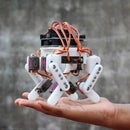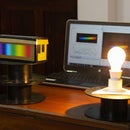Introduction: Galaxy Mood Lamp
Space is captivating studed with stars and planets. But nothing is more enchanting and relaxing than looking up at a clear starry sky and gazing into the vastness . In this project, we attempt to recreate this immerisve experience by making a galaxy inspired mood lamp. Placed on a desk or a bedside table the lamp looks like a portal to the night sky.
The lamp was made using digitally fabricated parts with the help of a lasercutter and 3d printer. The curved frame is made out of black acrylic to imitate the sky and gives depth to the lamp when looked at. If you like this project do support it by dropping a vote for it in the "Space Contest".
Step 1: Using Fusion 360 to Design the Mood Lamp
We chose a curved surface to give the galaxy lamp depth and make the experience as immersive as the night sky. Once we finalized the design on paper, we shifted to the computer, and 3D modeled the design on Fusion 360. First, we created the base section of the lamp by measuring the dimensions of the wood. Next, we designed the curved section of the lamp that would eventually be made out of acrylic. The acrylic panels are held together using 3D printed guides. Finally, the front panel of the lamp was made using a picture of the night sky that we had taken earlier. We used an image editing software to draw the contours of each star and saved the file as a dxf, which then served as away to make the pattern in Fusion 360.
Step 2: Materials Needed
The materials required for this project are commonly available and costs under 30$ :
- 1" x 4" Pine Wood Plank - of length50 cm
- 2mm Acrylic Sheet - of dimensions60 cm by 30 cm
- PLA Filament - ideally black in colour for the effect
- LED Strips x 8 - of length 20 cm
- 1/2" Wood Screws x 10
- DC barrel jack
- 12V Power Supply
Step 3: 3D Printing and Laser Cutting
A laser cutter and 3D printer were used to build the custom parts of the galaxy mood lamp. The laser cutting files and stls can be found attached below. Make sure to use 2mm acrylic for the laser-cut pieces, anything thicker will not fit into the guides and anything thinner will be too loose. The 3D printed parts were printed at 40% infill with 3 perimeters. Our printer was not big enough to print the entire guide in one go, which is why we split the guide down the middle and printed it in two parts. Stls of both versions are available. If one can get there hands on 2mm polycarbonate we would recommend using that for the front and back panels due to its flexibility. As we had acrylic we needed to heat bend the panels to the right curvature, which worked well though it was just an added trickier process that can be avoided.
Laser-cut parts:
- Front Panel
- Back Panel
- Side Panel (left)
- Side Panel (right)
- Top Panel
3D printed parts:
- Guide Front Left
- Guide Front Right
- Guide Back Left
- Guide Back Right
- Leg Left
- Leg Right
- Lid Left
- Lid Right
Attachments
Step 4: Attaching the 3D Printed Guides
Since our 3D printer was not big enough to print the guides as a single piece, we had to be careful to achieve a perfect alignment so that the panels fit well. To stick the guides to the side panels we used super-glue. Add a few drops of super glue to the guides and stick them to the panel making sure that the edges are flush to one another. Next, use a pair of clamps to hold the parts together to make a firm joint. Do this for all 4 guides (8 if you printed the pieces in parts).
Step 5: Heat Bending the Front and Back Panels
As acrylic is a pretty rigid material for it take the right curvature one needs to heat it and gradually bend it. If never done before this can be a tricky process as an excess of heat can make the panel extremely flimsy and thus making it deform whereas to little heat and it won't maintain its shape. We therefore recommend practicing an extra piece of acrylic by gently moving the hot air gun back and forth.
For bending the large front and back panels we laid it on the table and let the top section that needed to be bent overhang. We gradually continued the back and forth process of bending and checking if it fits till it had the perfect curvature. Repeat this process for both the front and back panels. Once done they should snap together and yet be held snuggly. The key to this step is patience.
Step 6: Soldering and Sticking the Led Strips
To get the effect of shining stars in the sky on the front acrylic sheet we used white LED strips attached to the back panel of the lamp. The LED strip was cut into lengths of 20 cms. We made 8 such strips and soldered them together using single core wires. On one of the ends we soldered an extension of wire about 10 cms long that was connected to a DC barrel. Test the connections by plugging the appropriate voltage (usually 12 V) to the input jack and make sure that all the LEDs light up.
Once the 8 led strips and the input jack are joined together, start sticking them to the back panel by maintaining a gap of 2 cm between strips.
Note: Make sure to be aware of the polarity of the LED strips while splicing them together. Poor quality LED strips may blow if the terminals are swapped.
Step 7: Prepping the Wood Base
The base of the galaxy lamp is made using 1" x 4" pine wood planks. Mark out 2 x 25 cms long pieces on the plank and cut them out using a saw. Next, hold the two 25 cm pieces together and sand the edges flush. On one of the pieces drill an 8mm hole. The position of this hole is not critical as it is used to hold the DC jack for powering the lamp.
Step 8: Mounting the Body to the Base
To mount the frame to the wooden base, start by passing the input jack through the hole provided for it. Using two wood screws secure the base together. Place the frame till it seats flush to the base and then place the printed legs. The top two holes align with the holes in the side panels. Mark the four hole positions on the side of the wooden base. Finally drill the pilot holes and secure the components in place using short wood screws. Place the lamp upright and it should feel sturdy without any wabble.
Step 9: Removable Top Panel
The top panel is held in place with two 3d printed parts that slide in between the interior guides. In this way one can always remove the top panel for internal maintenance. Simply stick the prints on both ends and slide the panel in place. The galaxy mood lamp is fully completed and is ready for display.
Step 10: Enjoy the Vastness of Deep Space
The effect of the galaxy lamp turned out better than expected. Simply connect a 12 volts power supply and the lamp comes to life. When kept on a bedside table or shelf the lamp dimly illuminates the surroundings and the curved panels add depth to the viewing experience. On the whole the contrasting black background makes it look pretty realistic almost like a starry night's sky.
Hope you enjoyed this concept and draw inspiration to build your own. If you liked the project do support it by dropping a vote in the "Space Contest".
Happy Making!

Second Prize in the
Space Challenge












